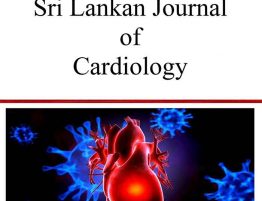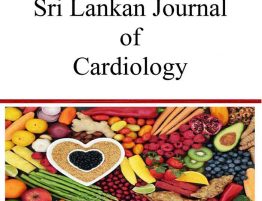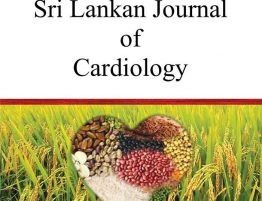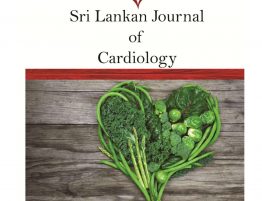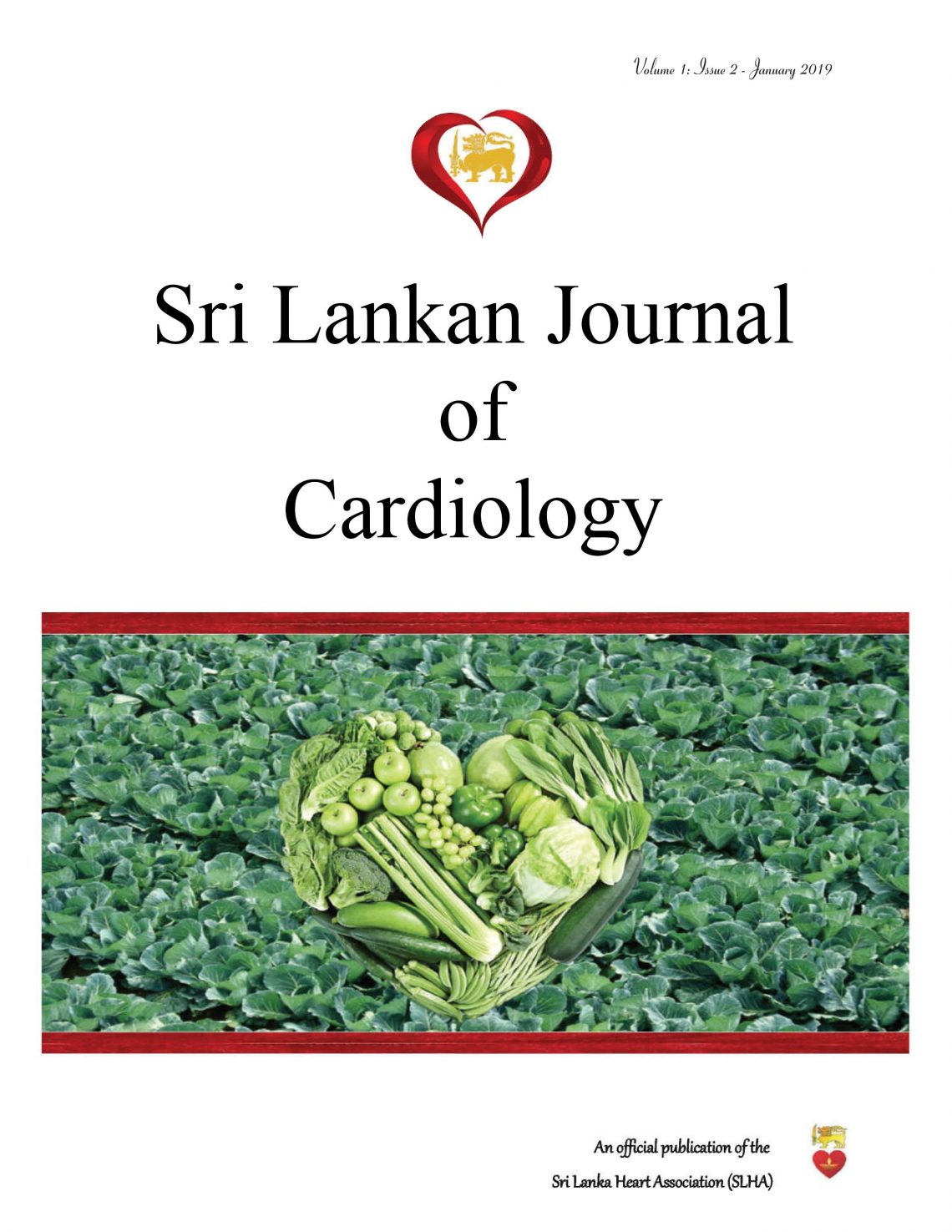
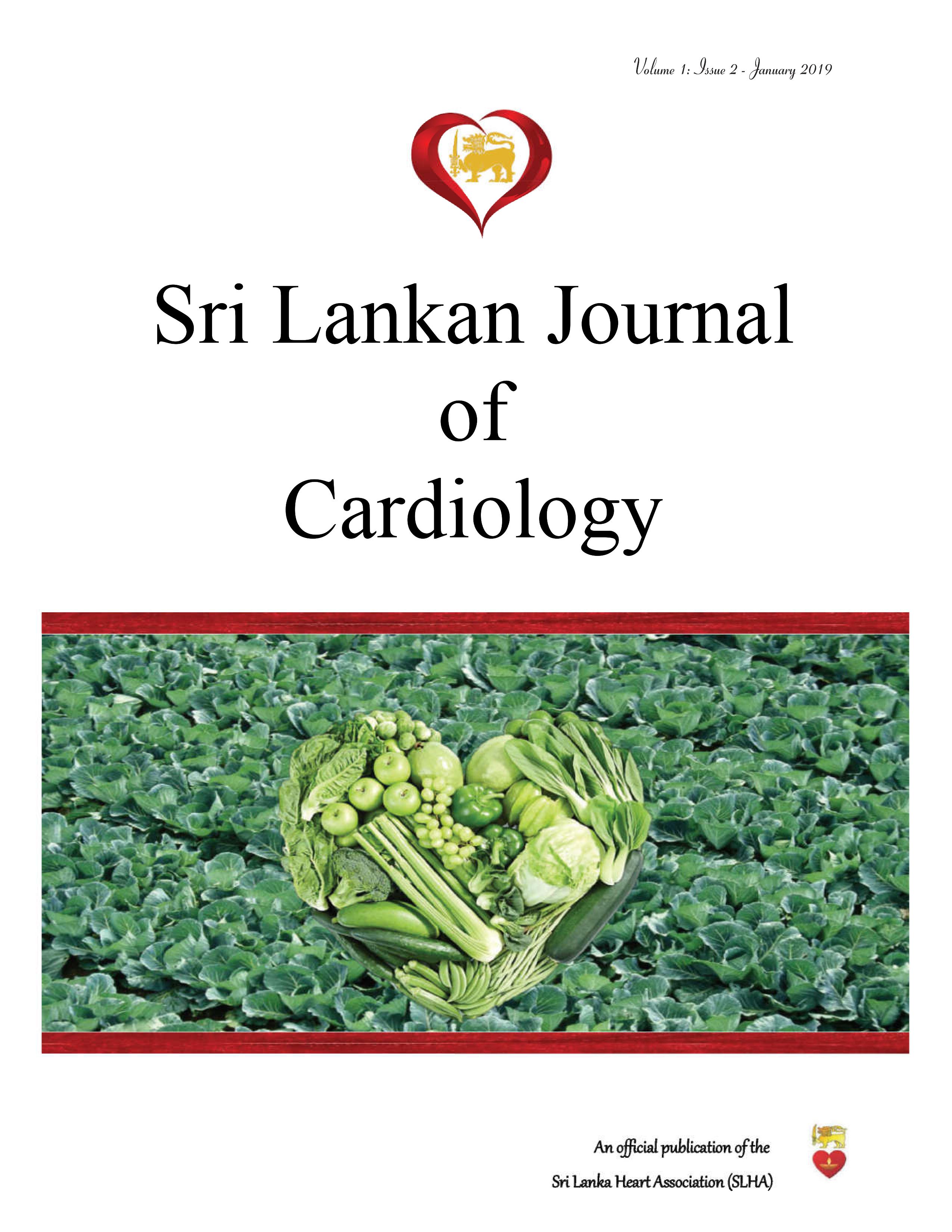
Sri Lankan Journal of Cardiology Volume 1: Issue 2 – January 2019
Abstract
The importance of the microbiome in the pathogenesis of metabolic diseases such as diabetes, hypertension, dyslipidaemia, obesity and cardiovascular diseases are emerging. The gut microbiome, once thought to have a limited function of producing vitamins and in bile acid metabolism is now known to be important in regulation of the gut barrier function, development and regulation of the immune system, glucose and lipid metabolism, synthesis of neurotransmitters and even regulation of our circadian rhythms. The composition and relative abundance of different microbiota play a pivotal role in health and disease. Microbial dysbiosis, which is characterized by reduced diversity of the microbiome with overabundance of bacteria of the Proteobacteria phyla, is associated with development of metabolic disease, autoimmune diseases, neuropsychiatric diseases and allergies. Such dysbiosis leads to metabolic endotoxemia resulting in a chronic inflammatory state and also leads to altered lipid and glucose metabolism.
Original Articles
-
Twiddler’s Syndrome 50 years and still counting
Twiddler’s Syndrome 50 years and still counting
Abstract
 It is said that human beings are creatures of habits. As such human behavioral patterns and acts are controlled either by volition or involuntary processes. Habits can also cast direct or indirect influence on a plethora of human ailments and suffering.
It is said that human beings are creatures of habits. As such human behavioral patterns and acts are controlled either by volition or involuntary processes. Habits can also cast direct or indirect influence on a plethora of human ailments and suffering.Download| PDF (EN) (3.1 MB)
-
The gut microbiome
The gut microbiome
Abstract
 The importance of the microbiome in the pathogenesis of metabolic diseases such as diabetes, hypertension, dyslipidaemia, obesity and cardiovascular diseases are emerging. The gut microbiome, once thought to have a limited function of producing vitamins and in bile acid metabolism is now known to be important in regulation of the gut barrier function, development and regulation of the immune system, glucose and lipid metabolism, synthesis of neurotransmitters and even regulation of our circadian rhythms. The composition and relative abundance of different microbiota play a pivotal role in health and disease.
The importance of the microbiome in the pathogenesis of metabolic diseases such as diabetes, hypertension, dyslipidaemia, obesity and cardiovascular diseases are emerging. The gut microbiome, once thought to have a limited function of producing vitamins and in bile acid metabolism is now known to be important in regulation of the gut barrier function, development and regulation of the immune system, glucose and lipid metabolism, synthesis of neurotransmitters and even regulation of our circadian rhythms. The composition and relative abundance of different microbiota play a pivotal role in health and disease.Download| PDF (EN) (1.6 MB)
-
Usefulness of Three-Dimensional Echocardiography in Clinical Practice
Usefulness of Three-Dimensional Echocardiography in Clinical Practice
Abstract
 Over the last decade, three-dimensional echocardiography (3DE) has become an important diagnostic modality in the evaluation and management of patients with heart diseases. The recent advancements in transducer and computer technologies have been very instrumental in implementing 3D technology in routine clinical practice. Moreover, we anticipate that with further hardware and software improvement, 3D image quality and workflow will continue to improve.
Over the last decade, three-dimensional echocardiography (3DE) has become an important diagnostic modality in the evaluation and management of patients with heart diseases. The recent advancements in transducer and computer technologies have been very instrumental in implementing 3D technology in routine clinical practice. Moreover, we anticipate that with further hardware and software improvement, 3D image quality and workflow will continue to improve. Download| PDF (EN) (5.3 MB)
-
Cardiotoxicity secondary to breast cancer chemotherapy
Cardiotoxicity secondary to breast cancer chemotherapy
Abstract
 Survival rates of breast cancer, have increased with improving chemotherapy and radiation therapy. The use of anthracyclines and transtuzumab have become the cornerstones in the treatment of breast cancer in both an adjuvant and metastatic therapeutic protocols. However, the adverse effects of both agents include cardiotoxicity, particularly left ventricular dysfunction, which limits their use.
Survival rates of breast cancer, have increased with improving chemotherapy and radiation therapy. The use of anthracyclines and transtuzumab have become the cornerstones in the treatment of breast cancer in both an adjuvant and metastatic therapeutic protocols. However, the adverse effects of both agents include cardiotoxicity, particularly left ventricular dysfunction, which limits their use.Download| PDF (EN) (2.1 MB)
-
Three Novel Genetic Markers That Could Predict Severe Coronary Artery Disease
Three Novel Genetic Markers That Could Predict Severe Coronary Artery Disease
Abstract
 This study will identify genetic predictors of coronary artery disease (CAD) severity and develop genomic profiles for accurate classification of high-risk patients in a clinical cohort.
This study will identify genetic predictors of coronary artery disease (CAD) severity and develop genomic profiles for accurate classification of high-risk patients in a clinical cohort.Download| PDF (EN) (850 KB)
-
Disease Burden of Rheumatic Heart Disease Among Children Attending the Paediatric Cardiology Unit Teaching Hospital Jaffna.
Disease Burden of Rheumatic Heart Disease Among Children Attending the Paediatric Cardiology Unit Teaching Hospital Jaffna.
Abstract
 Rheumatic heart disease is the most common cause of acquired heart disease in children worldwide. It causes significant morbidity and mortality in developing countries.
Rheumatic heart disease is the most common cause of acquired heart disease in children worldwide. It causes significant morbidity and mortality in developing countries.Download| PDF (EN) (878 KB)
-
Prevalence of malnutrition in children with congenital heart disease awaiting cardiac interventions at a tertiary care setting in Sri Lanka
Prevalence of malnutrition in children with congenital heart disease awaiting cardiac interventions at a tertiary care setting in Sri Lanka
Abstract
 Rheumatic heart disease is the most common cause of acquired heart disease in children worldwide. It causes significant morbidity and mortality in developing countries.
Rheumatic heart disease is the most common cause of acquired heart disease in children worldwide. It causes significant morbidity and mortality in developing countries.Download| PDF (EN) (1.0 MB)
-
Introducing TAVI to Sri Lanka
Introducing TAVI to Sri Lanka
Abstract
 In recent times the field of cardiology in Sri Lanka has seen a great development. Its’ importance being recognized has led to the setting up of a separate cardiac unit, which is the Institute of Cardiology, the premier national referral center for the entire country, located within the premises of the National Hospital of Sri Lanka.
In recent times the field of cardiology in Sri Lanka has seen a great development. Its’ importance being recognized has led to the setting up of a separate cardiac unit, which is the Institute of Cardiology, the premier national referral center for the entire country, located within the premises of the National Hospital of Sri Lanka. Download| PDF (EN) (2.0 MB)
-
When blood pressure is not under control Ten questions to ask and steps to take
When blood pressure is not under control Ten questions to ask and steps to take
Abstract
 In recent times the field of cardiology in Sri Lanka has seen a great development. Its’ importance being recognized has led to the setting up of a separate cardiac unit, which is the Institute of Cardiology, the premier national referral center for the entire country, located within the premises of the National Hospital of Sri Lanka.
In recent times the field of cardiology in Sri Lanka has seen a great development. Its’ importance being recognized has led to the setting up of a separate cardiac unit, which is the Institute of Cardiology, the premier national referral center for the entire country, located within the premises of the National Hospital of Sri Lanka. Download| PDF (EN) (846.0 kB)
-
Rapid Journal Scan
Rapid Journal Scan
Abstract
 Awad K, et al. conducted a meta-analysis of RCTs and quasi-RCTs to synthesize evidence about the efficacy and safety of alternate-day vs daily dosing of statins. The study searched selected databases to identify relevant RCTs and quasi-RCTs
Awad K, et al. conducted a meta-analysis of RCTs and quasi-RCTs to synthesize evidence about the efficacy and safety of alternate-day vs daily dosing of statins. The study searched selected databases to identify relevant RCTs and quasi-RCTsDownload| PDF (EN) (978.0 kB)
-
Myocardial infarction type
Myocardial infarction type
Abstract
 MI caused by atherothrombotic coronary artery disease (CAD) and usually precipitated by atherosclerotic plaque disruption (rupture or erosion) is designated as a type 1 MI.
MI caused by atherothrombotic coronary artery disease (CAD) and usually precipitated by atherosclerotic plaque disruption (rupture or erosion) is designated as a type 1 MI.Download| PDF (EN) (461 KB)
-
Ten commandments’ for Myocardial Revascularization (2018 ESC/EACTS)
Ten commandments’ for Myocardial Revascularization (2018 ESC/EACTS)
Abstract

Objective evidence of myocardial ischaemia by non-invasive stress imaging and/or intravascular assessment of the functional relevance of coronary artery stenosis are needed to indicate myocardial revascularization through PCI or CABG and to select the appropriate targets for PCI.
Download | PDF (EN) (329 KB)
-
Life Threatening Thrombo Embolic event following Dengue hemorrhagic fever
Life threatening thrombo embolic event following Dengue hemorrhagic fever
Abstract

Dengue fever (DF) is a highly prevalent infectious disease in Sri Lanka. Even though hemorrhagic manifestations are common in Dengue Hemorrhagic Fever (DHF), thrombo-embolic events are uncommonly reported, despite the wide range of increased procoagulant activity during Dengue fever. Management of a life threatening thromboembolic event during and immediately after DHF is a challenge for
treating physician due to high risk of bleeding complications.
Download | PDF (EN) (1.5 MB)
-
Entrapped hydrophilic coat of short guide
Entrapped hydrophilic coat of short guide
Abstract

Construction and design of angiographic guide wires are technologically advancing in a rapid manner by which percutaneous interventions are safer. Complications associated with such device failure are rare and most of these are related to fracture entrapment of distal part of the guide wire. Entrapment and fracture of such interventional and therapeutic devises within the coronary circulatory system is a rare but increasingly recognized clinical problem.
Download | PDF (EN) (863 KB)
-
Percutaneous Closure of Left Main Coronary Artery
Percutaneous Closure of Left Main Coronary Artery
Abstract

Coronary artery fistulae are rare with a prevalence of 0.1- 0.2% in routine angiograms1. Most of the patients are picked up incidentally due to a continuous murmur. Fistulae can lead to angina, palpitations, syncope or even infective endocarditis. Although surgery is the mainstay of treatment, close clinical follow up in asymptomatic patients and trans catheter device closure later are being practiced with successful outcomes.
Download | PDF (EN) (2.5 MB)
-
Resolution of Premature Ventricular Contraction
Resolution of Premature Ventricular Contraction
Abstract

Radiofrequency ablation was performed for PVC mediated cardiomyopathy. We used a combination of 12-lead ECG vector analysis, local activation time mapping, pace mapping and 3 dimensional electroanatomic mapping combined with contact force technology and irrigated ablation to accurately identify the PVC focus and deliver radiofrequency energy to the target area.
Download | PDF (EN) (5.4 MB)
-
Case series of Tuberculous pericarditis treated at Central Chest Clinic, Borella
Case series of Tuberculous pericarditis treated at Central Chest Clinic, Borella
Abstract

Tuberculous pericarditis is one of the rare manifestation of Tuberculosis. We analyzed patients with Pericardial tuberculosis treated at the Central chest clinic Borella between 2016 January / 2018 August. To establish the diagnosis of Tuberculous Pericarditis 2DECHO cardiogram and pericardial fluid aspiration should be performed in all suspicious patients. Early treatment is required in order to prevent complications.
Download | PDF (EN) (442 KB)
-
Ortner’s Syndrome as an uncommon presentation
Ortner’s Syndrome as an uncommon presentation
Abstract

More than a century ago a cardiovocal syndrome was described by Ortner where he attributed a case of left vocal fold immobility to compression of the recurrent laryngeal nerve by a dilated left atrium in a patient with mitral valve stenosis. Currently the term Ortner’s syndrome has come to encompass any nonmalignant, cardiac, intrathoracic process that results in embarrassment of either recurrent laryngeal nerve-usually by stretching, pulling, or compression; thereby causing vocal fold paralysis. Not surprisingly, the left recurrent laryngeal nerve with its longer course around the aortic arch is more frequently involved than the right nerve, which passes around the subclavian artery.
Download | PDF (EN) (1.9 MB)
-
Recurrent hemoptysis following coronary artery
Recurrent hemoptysis following coronary artery
Abstract

Coronary artery bypass graft surgery is known to cause complications, of which pseudo-aneurysm formation of the ascending aorta is an uncommon presentation. Haemoptysis as a presenting feature of pseudo-aneurysm is also infrequent
Download | PDF (EN) (3.9 MB)
-
Prevention of syncope and convulsions
Prevention of syncope and convulsions
Abstract

Vasovagal syncope is one of the reflex syncope’s which is commonly seen in children. Generally, symptoms are self-limiting and most patients can be managed conservatively with physical maneuvers and attention to good hydration. The two mechanisms described are cardio-inhibitory type, which is due to a sudden fall in the heart rate and the vaso-depressor type where there is a precipitous drop in blood pressure.
Download | PDF (EN) (1.4 MB)
-
Secondary Prophylaxis Of Coronary Artery Disease
Secondary Prophylaxis Of Coronary Artery Disease
Abstract

Non communicable diseases are becoming more prevalent than communicable diseases worldwide including Asian, Asia- Pacific and South Asian countries1. They are getting more common among the socioeconomically lower class than privileged class 2,3. Non communicable diseases related deaths in South-East Asian region, increased from 6.7 million in 2000 to 8.5 million in 2012 3. In Sri Lanka, premature non communicable disease mortality was 17.6% in 2012 3. The leading cause of hospital deaths in Sri Lanka was ischemic heart disease and there were 30 deaths per 100, 000 population in 2014 4,5 . In the Asia- Pacific region in hospital mortality from acute coronary syndrome is more than 5 % 1.
Download | PDF (EN) (918 KB)

